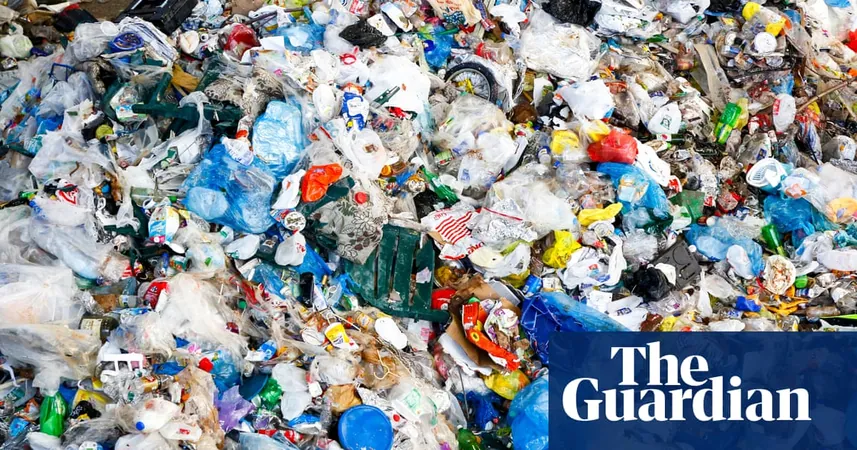
Urgent Call to Action: Protect Children from the Dangers of Toxic Chemicals
2025-01-08
Author: John Tan
Introduction
In an alarming revelation, health experts have come together to call for immediate reforms to protect children from the rising health threats posed by synthetic chemicals. A groundbreaking paper published recently in the New England Journal of Medicine (NEJM) sheds light on the disturbing link between chemical exposures and a surge in childhood diseases, urging worldwide legislative change.
Key Findings of the Report
The report, authored by over 20 prominent public health researchers—including specialists from the US Environmental Protection Agency (EPA) and the United Nations—highlights an overwhelming body of evidence correlating various childhood ailments, such as cancers and neurodevelopmental disorders, with the prevalence of man-made chemicals. Renowned public health advocate Linda Birnbaum, a co-author and former head of the US National Institute of Environmental Health Sciences, emphasizes the necessity for a “call to arms” to tackle this dire situation.
Institute for Preventive Health
A significant part of this initiative includes the launch of the Institute for Preventive Health, aimed at implementing the paper’s recommendations and facilitating necessary reforms. Among its prominent members is Anne Robertson, a figure from the family behind RJ Reynolds Tobacco, underscoring the diverse coalition advocating for change.
Escalating Chemical Production and Childhood Illnesses
The paper depicts a concerning trend: the global inventory of synthetic chemicals and their mixtures has ballooned to approximately 350,000, with production levels escalating 50-fold since 1950, and predicted to triple by 2050. Concurrently, the paper notes a dramatic increase in noncommunicable diseases among children—now a leading cause of death and morbidity—linked directly to these chemical exposures.
Concerning Statistics
Striking data reveals a 35% rise in childhood cancers, a doubling of male reproductive birth defects, and neurodevelopmental disorders affecting one in six children. Alarmingly, autism spectrum disorder is now identified in one in 36 children, alongside a tripling of pediatric asthma cases and a near quadrupling in obesity rates, which in turn has fueled an alarming uptick in Type 2 diabetes among minors.
Neglected Health Concerns
Tracey Woodruff, another co-author, asserted that children’s health has gradually slipped off the public health agenda, asserting a failure by both medical professionals and government entities to prioritize their well-being. The paper details research indicating that even minimal exposures to harmful chemicals during crucial developmental periods can result in long-term health issues, with prenatal exposures being particularly detrimental.
Economic Impact of Chemical-Related Diseases
The financial ramifications of these chemical-related diseases are staggering. The authors highlight the burden placed on governments and taxpayers, as the chemical industry often externalizes costs related to healthcare and lost productivity from these health impacts.
Critique of Existing Regulations
The paper critiques the existing US Toxic Substances Control Act (TSCA) as insufficient for safeguarding public health, arguing that the regulations are outdated and fail to provide robust oversight on the myriad chemicals in circulation. Unlike Europe, where chemical oversight is comparatively stricter, the system still relies heavily on industry-provided data, leading to significant gaps in consumer safety.
Proposed Solutions
To combat this growing crisis, the authors propose a global precautionary principle, demanding rigorous independent testing of chemicals before they hit the market, rather than assuming their safety until proven otherwise. This shifts the burden of proof onto manufacturers, obligating them to demonstrate the non-toxicity of their products upfront.
Global Treaty on Chemicals
Furthermore, the establishment of a legally binding global treaty on chemicals, overseen by the United Nations, is seen as essential. This treaty would enforce strict guidelines and mandate full disclosure of chemical risks and usage by manufacturers.
Conclusion
As pollution from synthetic chemicals escalates into a pressing global concern threatening children’s futures, health experts are clear: we can no longer afford to ignore the problem. The need for action is urgent, and in the wake of potential political shifts towards deregulation, the fight for reform has never been more critical.
The time for change is now—failure to act could have severe consequences for generations to come. Will policymakers heed this urgent call to action, or will the health of our children continue to be put at risk?




 Brasil (PT)
Brasil (PT)
 Canada (EN)
Canada (EN)
 Chile (ES)
Chile (ES)
 Česko (CS)
Česko (CS)
 대한민국 (KO)
대한민국 (KO)
 España (ES)
España (ES)
 France (FR)
France (FR)
 Hong Kong (EN)
Hong Kong (EN)
 Italia (IT)
Italia (IT)
 日本 (JA)
日本 (JA)
 Magyarország (HU)
Magyarország (HU)
 Norge (NO)
Norge (NO)
 Polska (PL)
Polska (PL)
 Schweiz (DE)
Schweiz (DE)
 Singapore (EN)
Singapore (EN)
 Sverige (SV)
Sverige (SV)
 Suomi (FI)
Suomi (FI)
 Türkiye (TR)
Türkiye (TR)
 الإمارات العربية المتحدة (AR)
الإمارات العربية المتحدة (AR)